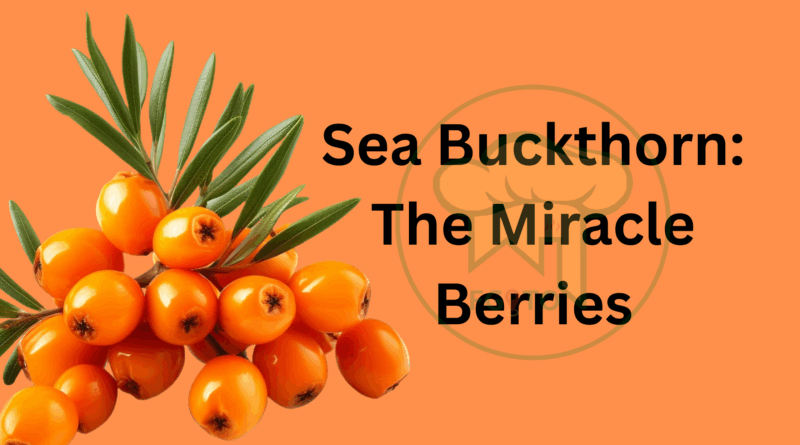From Himalayan Roots to Shark Tank Fame: Why Sea Buckthorn Deserves Your Attention
When Sea Buckthorn berries were introduced on Shark Tank India, it wasn’t just a product pitch; it was a cultural moment. Suddenly, a plant known only to wellness experts and traditional medicine practitioners stepped into the national spotlight. The founder’s passion, paired with its remarkable benefits, sparked a flurry of curiosity across households and health circles alike.
But for me, the journey started a little differently. Months ago, while casually scrolling through Instagram Reels, a kindly grandfather appeared on my screen, enthusiastically explaining the magic of sea buckthorn—its healing powers, nutritional richness, and age-defying qualities. His genuine tone made me pause, save the video, and start digging. What I discovered is a berry that’s not just trendy—it’s timeless.

A Berry Born in the Himalayas
Sea buckthorn (botanical name: Hippophae rhamnoides) is a hardy shrub that thrives in high-altitude, nutrient-poor soil—particularly in the Himalayan regions of Ladakh, Himachal Pradesh, and parts of Arunachal Pradesh. What makes it so special? The plant survives and even flourishes in harsh climates, absorbing the purest nutrients from the soil, water, and sun.
Despite its increasing global fame, sea buckthorn has always had roots in Indian traditions. In the cold deserts of Ladakh, it’s known as Leh Berry, where locals have long brewed it into teas and tonics to boost immunity, fight cold, and heal the body. In India’s traditional medicine systems, it’s also known as Sanjivani Booti, echoing the legendary herb believed to revive Lord Lakshmana in the Ramayana.
Ancient Mentions: Greek & Indian Legacy
Its use dates back to ancient Greece, where warriors fed it to horses to improve their vitality and coat shine—hence the name hippo (horse) and phaos (shine).
But in India, Sea Buckthorn earned a deeper place in healing. Classical Ayurvedic texts refer to it under various names, praising its rejuvenating and balancing properties. In Tibetan medicine, it’s part of holistic remedies used to treat respiratory issues, indigestion, wounds, and gynecological disorders.
So while modern wellness influencers may call it a superfood, Ayurveda and Siddha practitioners would simply call it familiar.
Nutritional Breakdown: Why It’s a Superfood
Sea buckthorn is not called the “miracle berry” without reason. Let’s look at what’s inside these tiny orange berries:
- 10x more Vitamin C than oranges—making it a powerful immunity booster
- Rich in antioxidants—including polyphenols, flavonoids, and carotenoids that fight free radicals and reduce inflammation
- All 4 Omega Fatty Acids (3, 6, 7 & 9)—rare in one plant source, great for heart, skin, and gut
- Packed with Vitamin E, Vitamin K, Magnesium, and Potassium—for muscle, bone, and cellular health
In short, this is not just food—it’s functional nutrition wrapped in a natural, bittersweet berry.
Health Benefits of Sea Buckthorn
1. Anti-Aging & Skin Glow:
The rich antioxidant content slows down skin aging, promotes collagen production, and enhances skin elasticity. Sea Buckthorn oil is commonly used in serums and creams for its healing and hydrating effects.
2. Gut & Digestive Support:
Ayurveda prescribes sea buckthorn for ulcers and indigestion. Its anti-inflammatory properties support gut lining and improve nutrient absorption.
3. Immune Boosting:
Thanks to its high vitamin C and bioflavonoid levels, it builds resilience against seasonal infections, especially in harsh winters.
4. Heart Health & Cholesterol Management:
Omega-7 (palmitoleic acid), a rare fatty acid in sea buckthorn, helps lower bad cholesterol and improves artery function.
5. Women’s Wellness & Hormonal Balance:
Traditionally used for gynecological issues, its adaptogenic properties are now studied for hormonal support during menopause and PCOS management.
6. Wound Healing & Inflammation Relief:
The oil extracted from the seeds and pulp speeds up wound healing, reduces swelling, and soothes skin conditions like eczema and psoriasis.
Modern-Day Uses: From Kitchen to Clinics
Today, Sea Buckthorn is being rediscovered—not just in traditional medicine cabinets, but also in gourmet kitchens, skincare labs, and supplement aisles.
- In Indian homes, locals in Ladakh use it in squashes, chutneys, and pickles. Herbal Sea Buckthorn tea is also a growing trend.
• In global kitchens: You’ll find it in smoothies, jams, energy bars, and even fine-dining desserts.
• In wellness: Sea Buckthorn capsules and oils are sold as immunity boosters and skin supplements.
• In skincare: The oil is a staple in anti-aging creams, lip balms, and sunscreens due to its high absorbability and healing properties.
Why This Matters to Indians Now
We often look west for wellness trends, but Sea Buckthorn is our very own Himalayan hero. It grows in our soil, features in our scriptures, and serves our health needs from the inside out. With rising health awareness and the resurgence of Ayurveda, now is the perfect time to reintroduce this miracle berry into our lives.
Moreover, when a product rooted in Indian tradition gets validation on a national platform like Shark Tank India, it encourages local farmers, boosts demand, and helps build a sustainable ecosystem around native superfoods.
Final Thoughts: The Berry That’s More Than a Trend
Sea Buckthorn isn’t just a viral moment. It’s a timeless remedy that has survived empires, fed kings and commoners, and healed generations. Whether you’re sipping it in a Ladakhi home, applying it as a face oil, or mixing it into your smoothie—this berry promises to nourish your body and soul.
So next time you spot “Sea Buckthorn” on a label or hear it mentioned in a conversation, know this: it’s not just a product. It’s a powerful story of nature, culture, and resilience—finally getting the recognition it deserves.




